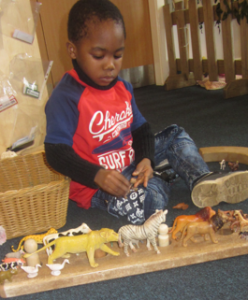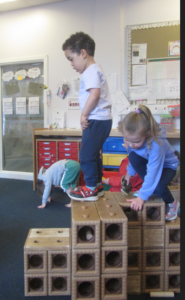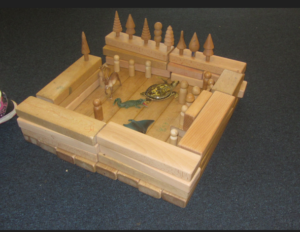Environment

Children learn many things from unit blocks. We have access to block play in all of our playrooms. The blocks are designed to be proportional in size to help children learn maths and other skills. Some of the maths skills they learn are counting, comparison of length and width, names of shapes, and how to combine some geometric shapes to make other shapes. They are learning the basics of addition when they discover that two short blocks will be the same length as the next size block.
Make sure that blocks are sorted and neatly arranged.
Always categorise blocks neatly when putting them away. Place them with the long side in view to make their size easily seen. – Kieff, J. and Wellhousen, K. (2001)

Stages of Block Play
Children’s play with blocks will change over time as their understanding and experience deepens. Knowledge of these stages allows practitioners to support children’s learning and provide what they need in order to take the next step.
Stages of block play include:
Carrying
Children explore the blocks using their senses – they examine them closely, touch and taste them.
Children hold one block in each hand and hit them together, exploring the sound.
Children carry the blocks from place to place.
Children knock down structures built by others.
No actual building takes place within the carrying stage.

Stacking
Children have a need to build rows and towers repeatedly – they do this before moving on to build other structures.
Children can haphazardly stack blocks until they fall.
Children can line blocks up, pushing them into an even line.
When children have mastered building rows and towers they build them in multiples – this can resemble floors and walls.
At this point children move on to the next stage.
Bridging
This is illustrated by children bridging or roofing the space between two upright blocks – the upright blocks need to be placed the correct distance apart to support the bridging block or the bridging block needs to be long enough.
Children can become confused at this stage if they place the upright blocks at either end of a base block and then the bridging block is not long enough when they have considered them all to be the same size.
Children who are persistent at this stage will be successful quicker than those that go back to the previous stage of building towers.
When a child has learned how to bridge they repeat it over and over again.
Children use this skill to build bridges on top of bridges.

Enclosures
Children use blocks to enclose space. They need to have a cognitive understanding of knowing which direction to turn the blocks to enable this to happen. Otherwise, they place the blocks end to end like a road.
Children need to practice to enable them to take four blocks and create an enclosure in the shape of a square.
When children can successfully do this they repeat it over and over, making many enclosures.
Children then begin to experiment with the size and shape of them and begin to connect one to the other.
Building complex structures
Children are fascinated with symmetry, balance and patterns – they use the blocks to form patterns and symmetrical designs.
Children use the blocks to express their creativity – the building techniques they have learned in the other stages are evident in their structures.
Children use a larger number of blocks – they incorporate towers, rows, bridges, enclosures and patterns in the same structure.
Children have mastered the basics of construction and design using blocks.
Children name their structures whilst they are building or after (not yet before) – this is usually in connection with staff questioning, “what are you building?”

Dramatic Play with complex structures
Children tell you what they are going to build before they start – this illustrates that children have a plan for their play with the blocks being used to set the scene.
The buildings children make resemble familiar structures.
The design features of the building represent the actual structure, for example, windows or a drawbridge.
Children create and add their own accessories to the structure, recycled materials (loose parts) supporting the dramatic play and their interpretation of how the world works.

